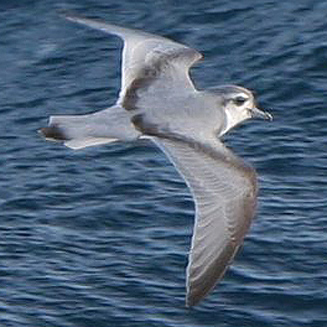|
Pachyptila belcheri
(Slender-billed prion)
Dunbekwalvisvoël [Afrikaans]; Dunbekprion [Dutch]; Prion
de Belcher [French]; Dünnschnabel-sturmvogel [German];
Painho-filtrador-de-bico-fino [Portuguese]
Life
> Eukaryotes >
Opisthokonta
> Metazoa (animals) >
Bilateria >
Deuterostomia > Chordata >
Craniata > Vertebrata (vertebrates) > Gnathostomata (jawed
vertebrates) > Teleostomi (teleost fish) > Osteichthyes (bony fish) > Class:
Sarcopterygii (lobe-finned
fish) > Stegocephalia (terrestrial
vertebrates) > Tetrapoda
(four-legged vertebrates) > Reptiliomorpha > Amniota >
Reptilia (reptiles) >
Romeriida > Diapsida > Archosauromorpha > Archosauria >
Dinosauria
(dinosaurs) > Saurischia > Theropoda (bipedal predatory dinosaurs) >
Coelurosauria > Maniraptora > Aves
(birds) > Order: Ciconiiformes
> Family: Procellariidae
 |
|
|
Slender-billed prion, offshore from Cape Town, South Africa. [photo
Trevor Hardaker ©] |
|
Distribution and habitat
Breeds at the Falklands and other islands off southern
South America, as well as in sub-Antarctic Islands, after which it disperses
across the southern oceans all the way down to 65° South. Its status in southern
African waters is uncertain, however it is generally scarce, occurring off the
coast of the Western Cape, Eastern Cape and KwaZulu-Natal.
Movements and migrations
Little known, although it is thought to breed
from about late August to February and March, so it is mainly
present in southern African waters from May-October.
Food
Generally eats larger animals than filter-feeding prions,
with a diet dominated by crustaceans, fish and squid. It mainly forages at
night, grabbing prey from the surface or plunge-diving up to a depth of about
3-5 metres.
Threats
Not threatened.
References
-
Hockey PAR, Dean WRJ and Ryan PG 2005. Roberts
- Birds of southern Africa, VIIth ed. The Trustees of the John Voelcker
Bird Book Fund, Cape Town.
|
